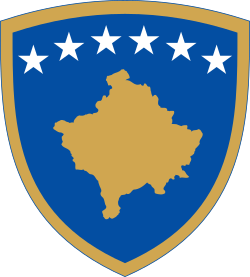Gjakova
Gjakova (Albanian: Gjakovë) or Đakovica (Serbian Cyrillic: Ђаковица; sometimes transliterated as Djakovica) is a city and municipality located in the Gjakova District of western Kosovo.[lower-alpha 1] According to the 2011 census, the city of Gjakova has 40,827 inhabitants, while the municipality has,94,556 inhabitants.[1]
Gjakova | |
|---|---|
City and municipality | |
    From top:Gjakova at Night, Old Bazaar, Saint Paul and Saint Peter Church in Gjakova, Hadum Mosque, Terzijski Bridge,Gjakova Clock Tower | |
 Emblem | |
| Coordinates: 42°23′N 20°26′E | |
| Country | Kosovo[lower-alpha 1] |
| District | District of Gjakova |
| Government | |
| • Mayor | Ardian Gjini (AAK) |
| Area | |
| • Urban | 13.189 km2 (5.092 sq mi) |
| • Municipal | 586.91 km2 (226.61 sq mi) |
| Elevation | 375 m (1,230 ft) |
| Population (2011) | |
| • Urban | 40,827 |
| • Urban density | 3,100/km2 (8,000/sq mi) |
| • Municipal | 94,556 |
| • Municipal density | 160/km2 (420/sq mi) |
| Time zone | UTC+1 (CET) |
| • Summer (DST) | UTC+2 (CEST) |
| Postal code | 50000 |
| Area code(s) | +383 390 |
| Car plates | 07 |
Geographically, it is located in the south-western part of Kosovo, about halfway between the cities of Peć and Prizren. It is approximately 100 km (62 mi) inland from the Adriatic Sea. The city is situated some 208 kilometres north-east of Tirana, 145 kilometres north-west of Skopje, 80 kilometres west of the capital Pristina, 435 kilometres south of Belgrade and 263 kilometres east of Podgorica.
The city of Gjakova has been populated since the prehistoric era. During the Ottoman period, Gjakova served as a trading center on the route between Shkodër and Istanbul. It was also one of the most developed trade centers at that time in the Balkans.
Name
The Albanian name for the town is Gjakova, while the Serbian name is Đakovica with the common -ica diminutive placename suffix. There are several theories on the origin of the village name, such as from the personal name Jakov; the Serbian word đak (pupil); or from the Albanian word for "blood" (gjak).[2]
The "Jakov theory" derives its name from Jakov, a little known nobility in the service of lord Vuk Branković who founded and ruled the town, and whose coins have been found, signed "Jakov".[3][4] According to local Albanians, the name was derived from the name Jak (Jakov), with the village name meaning "Jakov's field".[5] According to Vujinović, it was also wrongfully claimed by the Albanians that the name was derived from a Jak Vula, a local landlord who allegedly gave property where the Hadum Mosque was built in the 1590s.[4]
In Albanian, the name was pronounced Jakova, and not Đakova or Đakovica (1928).[5] The "pupil theory" has it that the Serbian kings had schools there,[2] the word đak is from earlier d(i)jak;[6][7]
History
Middle Ages
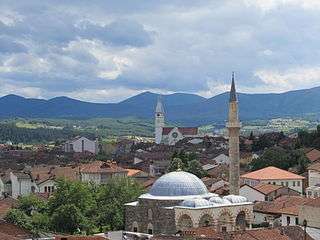
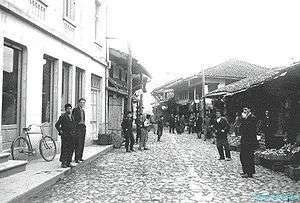
In the Ottoman defter (tax registry) of 1485, the "village of Đakovica" had 67 households, among which there was the house of "Vukašin's son, the priest".[3] Based on the study of the names, only two household heads were of possible Albanian origin.[4] In the 17th century, Katip Çelebi and Evliya Çelebi mention this place as Jakovičse, with 2000 houses and 300 shops.[3]
The town had developed into an Ottoman trade center on the Shkodra–Istanbul route, with the marketplace being by the Hadum Mosque, built in 1594 by Mimar Sinan, financed by Hadum Aga. Evliya Çelebi mentioned it as a town in 1662, and described it as a flourishing and attractive town with 2,000 houses built of stone with roofs and gardens. The public buildings were situated on a broad plain and included two richly adorned congregational mosques, several prayer-houses, some inns with leaden roofs, a delightful bath-house (hamam), and about 300 shops like nightingale-nests.[8]
Modern Period
Gjakova suffered greatly from the Serbian and Montenegrin armies during the First Balkan War. The New York Times reported in 1912, citing Austro-Hungarian sources, that people on the gallows hanged on both sides of the road, and that the way to Gjakova became a "gallows alley."[9] In the region of Gjakova, the Montenegrin military police formed the Royal Gendarmerie Corps (Kraljevski žandarmerijski kor), known as krilaši, which committed much abuse and violence against the non-Orthodox Christian population.[10]
Kosovo War
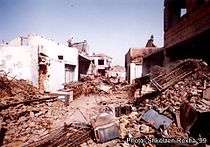
The town was badly affected by the Kosovo war, suffering great physical destruction and large-scale human losses and human rights abuses. Yugoslav units were stationed in and near the town in two barracks due to the risk of an attack by the Kosovo Liberation Army (KLA) from across the border in Albania. In one incident, NATO aircraft misidentified a convoy of Albanian refugees and attacked it.
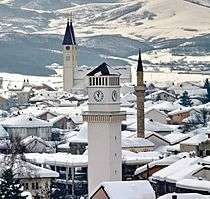
Actions on the ground had a devastating effect on the town. According to the ICTY, OSCE, and international human rights organisations, about 75% of the population was expelled by Serbian police and paramilitaries as well as Yugoslav forces, while many civilians were killed in the process.[11][12] Large areas of the town were destroyed, chiefly through arson and looting but also in the course of localised fighting between government security forces and members of the KLA. The actions of the government forces in Gjakova formed a major part of the United Nations war crimes indictment of the then-President Slobodan Milošević. In 2011, several dozen corpses were identified and returned to their families, though the number is relatively small compared to the figures of those who are still missing.
Aftermath of Kosovo war
Most of the Albanian population returned following the end of the war. In 2001 free elections were held, with a majority won by LDK. Thousands of new stores were rebuilt. Old town is a good example where hundreds of stores were destroyed during the war; in 2001 as many were rebuilt as there had been before the war. New television and radio media were launched such as Radio Gjakova, Radio Pandora, Radio Amadeus, and TV Syri. Local businesses set up manufacturing enterprises such as the IMN brick factory.
Geography
Gjakova is located in the south-western part of Kosovo. To the north-east of the city, the west Kosovan plain of Dukagjini opens, while in the south-west the peak of Dinaric Alps rises. The city is also situated at the entrance to the Erenik Valley, where the river Krena flows from the north to the Erenik mountain stream. After a few kilometers, it flows into the White Drin, the longest river in Kosovo. The municipality covers an area of 521 km2, including the town of Gjakova and 84 villages.
Demographics
| Year | Pop. | ±% p.a. |
|---|---|---|
| 1948 | 39,998 | — |
| 1953 | 44,415 | +2.12% |
| 1961 | 53,270 | +2.30% |
| 1971 | 71,374 | +2.97% |
| 1981 | 92,303 | +2.60% |
| 1991 | 115,097 | +2.23% |
| 2011 | 94,556 | −0.98% |
| 2016 est. | 94,543 | −0.00% |
| Source: Division of Kosovo | ||
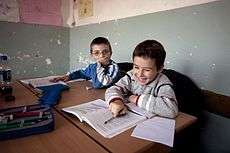
According to the 2011 census, the resident population was 94,556, of which urban inhabitants numbered 40,827 and rural 53,729; there were 47,226 males and 47,330 females. The ethnic groups include Albanians (87,672), Balkan Egyptians (5,117), Roma (738), Ashkali (613), and smaller numbers of Bosniaks (73), Serbs (17), Turks (16), Gorani (13) and others.[1] Based on those that answered, the religious make-up was 77,299 Muslims, 16,296 Roman Catholics, 22 Orthodox Christians, 142 others, and 129 irreligious.[1] Based on the population estimates from the Kosovo Agency of Statistics in 2016, the municipality has 95,433 inhabitants.
According to OSCE estimations, before the Kosovo War of 1999 the municipality had a population of about 145,000, of which 93% were Kosovo Albanians and 7% non-majority communities, including some 3,000 Serbs, who mostly lived in the main town.[13]
Education
Gjakova has a long tradition of education since the beginning of civil life. According to the Gjakova tradition the Hadim Aga library was so rich in books so it was said "Who wants to see the Kaaba, let them visit the library of Hadim Aga". The library had a reading room on the ground floor and the shelf with books upstairs.[14]
According to some data, schools in Albanian language in the territory of Gjakova, were opened before 1840.[14] The Albanian intellectuals from the city, that were educated in the most important educational centers of the Ottoman Empire, had a special role in opening of schools in the Albanian language during the Albanian National Movement.[14]

A particular role in enriching the educational tradition in the region of Gjakova and beyond was the opening of religious schools, initially schools, later the madrasas.[14]
The city has become an important university town. Today in the municipality of Gjakova, there is also a large number of primary and secondary schools, in the public sector, as well as in the private sector. The education system is organized in many schools and in the separate physical activity classes. During 2004, there was development respectively. There has been an increase in the number of private institutions, especially at the preschool level, but also in primary and secondary education.[14]
The University of Gjakova Fehmi Agani, is one of the newest public universities in Kosovo. The University began operating on 1 October 2013.[15] In 2014, the Gjakova Summer School for Entrepreneurship were opened in the city.[16]
Religion
Kosovo does not have an official religion. As the rest of the country, the majority of Gjakova's population consider themselves Muslim. The minority of Gjakovas's religious population that is not Muslim practices Christianity in the form of Roman Catholicism and Eastern Orthodoxy. According to the census of 2011, the prominent religion is Islam, including 81.75% of the population, while 17.23% is Roman Catholic Christian, 0.02% Orthodox Christian and 1% other.[17] Religious communities have educational institutions for their needs organized in accordance with applicable law.
All inhabitants of Gjakova have the right to freedom of belief, conscience and religion, which are guaranteed to all persons in Gjakova and Kosovo. Christianity has been around in Gjakova for a long time, going back all the way to the time of the Dardanian Kingdom and Roman Empire. Islam in Gjakova began to be spread very early, during the Ottoman Rule. Before the Battle of Kosovo in 1389 the whole Balkan was Christianized by the Western and Eastern Roman Empire. From that time until 1912 Kosovo was governed by the Ottoman Empire resulting in high level of Islamization.
Most Catholics live in the Rruga e Katolikëve street, where the two main churches are, and others in villages. The Muslims, living in other parts of the city and in most villages, have been encouraging the building of mosques, which could have counted about 10–15 buildings during the centuries.
Economy
Gjakova built an economy based on farming and agriculture, lower trade and some types of manufacturing workshops which mainly produce for the needs of city-based products as imported cases. After World War II, Gjakova has built an economy based on industry and agriculture but also in the service sector. Nowadays, these subsequent shifts in transitional societies are escorted with shifts in the economic structure of the city. Therefore, Gjakova has an economic structure that is based on two pillars: in the private business sector and social business sector which is currently being privatized. Private business sector is in expansion and the main indicators qualify it as the main component of Gjakova's economy.[18]
According to official sources identified in the Ministry of Trade and Industry, by the end of 2005 there were about 3,200 registered businesses that exercise activity in different areas of Gjakova, such as enterprise manufacturing, construction, service, trade, catering, craft, transportation, information technology, etc. Social economy in 1989 has counted 45 companies that have employed 18,640 workers. In non-economic activities (education, health, culture, government institutions, banks, etc.) there were employed 4000 workers. Furthermore, they also developed the private economy – where in 2010 approximately 920 employees were registered in the business entities. The economy of the municipality of Gjakova suffered mostly during the economic sanctions and the mass violence done by Serbian forces during the war. The situation further during NATO's intervention as a result of the destructive actions of multiple military and police forces, which have stood and operated in the economic enterprise facilities. This meant that during their withdrawal, these Serbian forces robbed, looted and destroyed most of the assets, inventories, transportation machines, etc. The losses that were done in the social economy as a result of the war were approximately 190 million DEM, whereas in the private economy around 100 million DEM.[18]
Post-war economy
According to official data, in 2006, there were 581 registered small and medium enterprises, in 2008 there were 3,120 such registered businesses, while in 2012 their number had reached 4,120. Gjakova currently has 12,000 people employed, in both the public and private sector, mostly in the latter. Although unemployment is high, there is a gradual increase of employment over the years according to data from the Kosovo Ministry of Work and Social Wellbeing. According to government statistics, in 2010, 40,000 people were registered as unemployed, while in 2011 this number decreased to 30,000 and in 2012 to 15,000. 30,000 people in Gjakova receive social assistance. This category includes poor families, people with disabilities, families of war veterans/victims and the retired.[19]
Industries
Potential industry sectors in the municipality of Gjakova are:[18]
- Metal industry, which produces metal ropes, nails, galvanized pipes, profiles of metal adhesive bandages. The existing industry also the production of electro motors for washing machines, engines for industrial applications, motors for hermetic compressors, finger jointed and Teflon containers, chimneys, elbows, enameled pots, technical gases, and chrome concentrate.
- Textile industry, which produced cotton spinning, cotton fabrics, artificial leather, underwear, lingerie costume for men, and different types of fabric (specifically jeans), etc.
- Chemical industry, involves production of the shampoo for domestic and industrial use and other chemical products which are used for household hygiene.
- Food industry, is mainly known with the production of flour, bread, eggs, pasta, chocolate, high quality wines, and fresh meat.
- Construction industry, Gjakova is also known for its construction materials industry, which involves the production of bricks, blocks, tiles, doors and windows, briquette, wooden cottages in the global level (log Houses ) and also the production of asphalt, fresh concrete, concrete slabs, and concrete pipes.
Capital investments
The municipal budget of Gjakova was subsidised by donations from USAID, CDF, Austrian Office in Kosovo, the European Commission and others, which over the past four years have done capital investments to the amount of €25 million: €5.4 million in 2010; €6.3m in 2011; €6.7m in 2012; €6.6m in 2013.[19]
The capital investments in the municipality of Gjakova are mainly focused on the regulation of roads including the rehabilitation, pavement and partially their lighting. However, investments for the expansion of the sewage system and the regulation of the canalization remain insufficient. The total amount of funds that are available to the municipality of Gjakova during a year for capital investments lies somewhere over 6 million euros.[20]
Private sector
Dominated by small family businesses, retail stores, cafeterias and providers of basic services, the private sector of Gjakova remains weak. It makes up only 5.5 percent of all businesses registered in Kosovo. According to the Tax Administration Office in Gjakova, 88 to 93 percent of active businesses are businesses with a single owner, five to ten percent are businesses with limited liability and the remaining two percent are large businesses. As in any other place in Kosovo, more than 90 percent of the sector consists of small family businesses which cannot create growth with added value. Only 2 out of 53 studied businesses in the centre of Gjakova declared not having employed any relative.
Gjakova's private sector, as in other places of Kosovo, is dominated by small businesses which hire 1–5 employees in activities with small added value, such as wholesale and retail, or other service activities such as restaurants and hotels. Wholesale and retail represent 50.5 percent of registered businesses. Other sectors include hotels and restaurants (10.2 percent), production (9.7 percent), transport and communication (7.8 percent), construction (4.2 percent) and agriculture (1.7 percent) among others.
Outside of the city's centre, Gjakova's private sector is characterized by ex-social ventures. Only one of the 15 privatized social ventures and one of the two ventures with common shares are completely functional. Both ventures have to do with construction. One of them is "Dukagjini" with 109 employees, which is one of the biggest private employers in Gjakova today. The other venture is "NIKI-S" which at present has 279 employees and is considered the biggest company in Gjakova's municipality.[21]
Transport
There are lots of infrastructure facilities of railways and platforms which currently are out of function.[22] Pristina International Airport is some 70 kilometres east of Gjakova. It is the only port of entry for air travelers to Kosovo. In northern of the city, there is the Gjakova Airport situated. The airport is expected to become public in the following years, to be used by low-cost commercial airlines and cargo flights.[23][24]
Culture
Historical monuments
Historical monuments in Gjakova are divided into three main categories based on their cultural, religious and social context. The core part of the town was created between the Krena River to the east and Cabrati hill to the west. Around the cornerstone of the town, the Old Bazaar – the center of trade and craftsmanship – was created. By 1900, the bazaar housed around 1000 enterprises. Numerous bridges were built to enable the journey of trade caravans across the neighboring rivers.[25] With the fast development of trade in the city, several inns were built to host the many visitors. Because of its ancient origins and fast economic development, Gjakova has become of great historical importance.[26]
The Old or Grand Bazaar (Çarshia e Madhe) in Gjakova is the oldest bazaar in Kosovo, and it served as an Ottoman trading centre and heart of the town economy. It suffered damage during the Kosovo War but has since been renovated. The Hadum Mosque, built in the 16th century, lies by the bazaar, and includes a highly decorated graveyard, where the town notables were buried. Within the mosque complex were the hamam which was destroyed in 2008, the "Old library" from 1671, damaged in the Kosovo War, and also a meytepi from 1777. The Bazaar is linked to the city centre, just five minutes away via the Islam-Beg Bridge. The bazaar covers an area of about 35,000 m2 (380,000 sq ft) and the length of its main road is 1 km, with about 500 shops situated along it. It is, however, still home to an active mosque, several türbes, and a clocktower.[27]
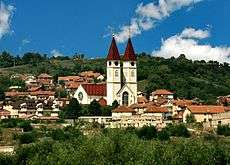
The Hadum Mosque, located in the Old Bazaar, built in 1594 by Ottoman architect Mimar Sinan and financed by Hadum Aga. The mosque has played a significant role in the urban character of the town from the 17th to 20th centuries. Its construction was followed by the appearance of the craftsmanship around it, which increased the importance of the town. The mosque holds historical value and is viewed of as a sacred monument. The great Tekke ("Teqja e Madhe"), built by the end of 16th century by Shejh Suleyman Axhiza Baba, a Sufi mystic from Shkodra. It belongs to the Saadi order of Sufism. The complex includes turbe (small mausoleums), samahanes (ritual prayer-halls), houses and fountains. It is characterized with detailed sacral architecture, with wood-carved elements.
Gjakova is also characterized with two main Catholic Churches, which are part of the cultural heritage. The Saint Paul and Saint Peter Church (Albanian: Kisha e Shën Palit dhe Shën Pjetrit) is one of the tallest monuments in Gjakova, which can be seen from different points of the town. The arrival of the Albanian Catholics form Malesia resulted in rejuvenation of Saint Peter's Church in Gjakova in 1703, while in 1851 Gjakova's parish is rejuvenated. In 1999, after the War it was totally destroyed. In the same site the new cathedral has been built.[28]
The Saint Ndou Church, was once called also the church of Padre Mila, who had built it in 1882, but it was later destroyed. In 1931, Padre Lorenc Mazrreku built in the same place the church that exists today, which was renovated few times, adding to it the guestrooms, offices and restrooms, but complying with the original architectural concept.[28]
The Clock Tower, built just after the Hadum Mosque at a place known as Field of the Clock, characterizes the rapid economic development of Gjakova at that time. It was destroyed during the Balkan Wars, while the belfry was removed and transported to Montenegro. With sides 4.10m long and a height of about 30 meters, a new clock tower was built later near the foundations of the previous one. Constructed mainly of stone with the wooden observation area and the roof covered in lead, the clock tower is unique of its kind.
Events and festivals
Events and festivals in Gjakova are not as much in numbers, as they are highly valued. The historic city of Gjakova, Kosovo, especially the Old Town, is the hub of many outdoor and indoor festivals, cultural events and street parades. Many of them are seasonal and take place only one time, while others are organised annually for many years by various festival societies. All of them draw interest from the locals and visitors alike. Some of the events are organised by the city, some by private companies as well.
Cityscape
Sport
Apart from being a culture and educative center of the Kosovo, Gjakova is also known as a sport center. The best example of this is the fact of having 38 clubs, which compete in all leagues over Kosovo. Gjakova's most successful team is KF Vëllaznimi which has won 9 titles of Kosovar Superliga and 4 Kosovo Cups. "Shani Nushi" is the city's sports hall, which has a capacity of 3500 seats, while the Gjakova City Stadium has a capacity of 6000 seats.
International relations
Gjakova is twinned with:
Notable people
- Amir Abrashi, Albanian footballer
- Fehmi Agani, Albanian sociologist, academic and politician
- Mahmut Bakalli, Kosovo Albanian communist
- Lorik Cana, Albanian footballer and captain on National football team of Albania
- Besim Dina, Albanian television host
- Masar Caka, Albanian painter
- Gent Cakaj, Albanian minister for Europe and Foreign Affairs
- Bardhyl Çaushi, Kosovo Albanian dean of law of the University of Pristina
- Bajram Curri, Albanian, founding member of the Committee for the National Defence of Kosovo
- Božidar Delić (born 1956), retired Yugoslav general and Serbian politician
- Teki Dervishi, Albanian playwright
- Rauf Dhomi, Albanian composer
- Mladen Dodić, Serbian football coach
- Abdullah Pashë Dreni, Albanian pasha
- Emin Duraku, Albanian, partisan
- Bekim Fehmiu, Yugoslav-Albanian actor, the first Eastern European to star in Hollywood during the Cold War
- Gëzim Lala, Kosovar Albanian football player who played for FK Galenika Zemun.
- Ardian Gashi, Albanian-Norwegian footballer
- Riza bej Gjakova, Albanian nationalist and guerrilla fighter
- Eros Grezda, Albanian footballer
- Besnik Hasi, Albanian footballer and coach
- Fadil Hoxha, Albanian, first Prime Minister of AP Kosovo
- Atifete Jahjaga, Albanian, former President of Kosovo
- Benet Kaci, Albanian media personality
- Valonis Kadrijaj, Albanian-German footballer
- Gjon Nikolle Kazazi was an Albanian Catholic bishop of Skopje, known for discovering Meshari of Gjon Buzuku.
- Ardian Kozniku, former Albanian-Croatian footballer
- Ahmet Koronica, Albanian nationalist
- Flaka Krelani, Albanian singer
- Naim Kryeziu, Albanian footballer, part of AS Roma's first Serie A win
- Burim Kukeli, Albanian footballer
- Festina Mejzini, Albanian singer
- Mimoza Kusari Lila, Kosovo Albanian politician
- Din Mehmeti, Albanian poet
- Avni Mula, Albanian musician
- Blerim Mula, Albanian footballer and manager
- Muslim Mulliqi, Albanian impressionist and expressionist painter
- Fadil Nimani, KLA fighter
- Dimitar Obshti, Bulgarian revolutionary
- Fanol Perdedaj, Albanian-German footballer
- Ali Podrimja, Albanian poet
- Mirlinda Kusari Purrini, Kosovo Albanian economist
- Aleksandar Tijanić, Serbian journalist and former RTS director
- Esat Valla, Albanian painter
- Miodrag Vlahović, Montenegrin former foreign minister
- Liza Vorfi, Albanian actress
- Vladimir Durković, Serbian football player and Olympic champion
Notes
- Kosovo is the subject of a territorial dispute between the Republic of Kosovo and the Republic of Serbia. The Republic of Kosovo unilaterally declared independence on 17 February 2008, but Serbia continues to claim it as part of its own sovereign territory. The two governments began to normalise relations in 2013, as part of the 2013 Brussels Agreement. Kosovo is currently recognized as an independent state by 97 out of the 193 United Nations member states. In total, 112 UN member states recognized Kosovo at some point, of which 15 later withdrew their recognition.
References
- "Të dhënat demografike sipas komunave" (PDF). Statistics Agency of Kosovo. April 2013. Retrieved 5 October 2013.
- Никола Чупић (1898). Годишњица Николе Чупића. Штампа Државне штампарије Краљевине Југославије. p. 151.
- Зборник Матице српске за ликовне уметности. Матица. 1990.
... господару овог места Јакову, вазалу Вука Бранковића Сачувано је и неколико примерака новца са натписом "Јаков", који је овај властелин ковао. У турском попису из 1485. уписано је ово место као "село Ђаковица" са 67 домова међу којима је и дом "попа сина Вукашина". Хаџи Калфа и Евлија Челебија у XVII веку помињу ово место као "Јаковичсе" са 2000 кућа и 300 дућана ..
- Janko Vujinović (1989). Kosovo je grdno sudilište. NIRO "Književne novine". pp. 96–97.
Ђаковица је име добила по Јакову, мало познатом феу- далцу, вазалу Вука Бранковића. Јаков је, наиме, оснивач и господар Ђаковице, бар тако, уз име "Иаков", пише на њего- вом новцу [...] Под именом "Јакова", "Јаковичса", "Јаково са околи- ном" и "Ђаковица" помиње се од раног средњег века Звоно, [...] Јак Вул>е, те по имену зем- љовласника место добија име Јаково, Ђаково, и до краја XIX века – Ђаковица Па сад, [...] У тур- ским, веома поузданим пореским тефтерима из 1485. годи- не, место по којем сам корачао у то пролетње поподне упи- сано је као "село Ђаковица" са 67 домаћинстава, од којих су само два домаћинства [...]
- Zapisi. Cetinjsko istorijsko društvo. 1928.
Арбанаси мештани пак кажу да је име Ђаковица дошло од имена Јак (Јаков) и ова шт0 значи поље, те би Јакова значило Ја- ковљево поље. У арбанашком језику Ђаковица се и зове Јакова, а •не Ђакова и Ђаковица.
- Madgearu, Alexandru (13 November 2007). "The Wars of the Balkan Peninsula: Their Medieval Origins". Scarecrow Press – via Amazon.
- Mirjana Detelić: Градови у хришћанској и муслиманској епици, Belgrade, 2004 ISBN 86-7179-039-8
- Elsie, Robert (2004). Historical dictionary of Kosova. 4501 Forbes Boulevard, Suite 200, Lanham, Maryland 20706: Scarecrow Press, Inc. ISBN 0-8108-5309-4.CS1 maint: location (link)
- "Servian army left a trail of blood" (PDF). The New York Times. 31 December 1912.
- "Krilaši", Istorijski leksikon Crne Gore, Podgorica: Daily Press, 2006
- "UNDER ORDERS: War Crimes in Kosovo – 6. Djakovica Municipality". Hrw.org. Retrieved 28 August 2017.
- "OSCE". Osce.org. Archived from the original on 22 February 2004. Retrieved 28 August 2017.
- OSCE "Mission in Kosovo: Municipal profile of Đakovica". Archived from the original on 11 October 2014., November 2005. Retrieved on 13 November 2007.
- "Education of Gjakova". Gjakovaportal.com. Retrieved 28 August 2017.
- "University of Gjakova "Fehmi Agani" – new.euforia-kosovo.com". euforia-kosovo.com.
- "Frontpage – GjakovaSummerSchool". GjakovaSummerSchool.
- "Të dhënat kryesore demografike sipas komunave" (PDF). Esk.rks-gov.net. Retrieved 28 August 2017.
- "Archived copy". Archived from the original on 1 March 2014. Retrieved 9 March 2014.CS1 maint: archived copy as title (link)
- "Mbijetesa e qytetit të harruar". Zeri.info. Archived from the original on 1 March 2014. Retrieved 28 August 2017.
- "Letërnjoftimi i Komunës së Gjakovës" (PDF). Institutigao.org. 2013. Retrieved 28 August 2017.
- "Archived copy" (PDF). Archived from the original (PDF) on 9 March 2014. Retrieved 9 March 2014.CS1 maint: archived copy as title (link)
- "REGIONAL POLICE DIRECTORATE – GJAKOVA – Policia e Kosovës – Policija Kosova – Kosovo Police -". Policia e Kosovës – Policija Kosova – Kosovo Police -.
- "Aeroporti i Kosovës në Gjakovë për cargo, çmime të lira dhe trajnime për pilotë". Zëri.info. Archived from the original on 17 January 2015. Retrieved 28 August 2017.
- "Aeroporti Gjakovë, news report". ABC News. Retrieved 19 December 2014.
- "Integrated Conservation". Cultural Heritage without Borders. Archived from the original on 2 April 2006.
- Broshura për promovimin e Gjakovës,CBDC
- "Churches". Gjakovaportal.com. Retrieved 28 August 2017.
- "Archived copy". Archived from the original on 2 November 2013. Retrieved 13 May 2013.CS1 maint: archived copy as title (link)
External links
| Wikimedia Commons has media related to Đakovica. |

- . Encyclopædia Britannica (11th ed.). 1911.

